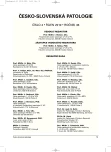Another Mechanism of Décollement
Authors:
P. Strejc 1; J. Šachl 2; A. Vlčková 3; J. Dreßler 4; D. Vajtr 1
Authors‘ workplace:
Ústav soudního lékařství a toxikologie 1. lékařské fakulty UK, Praha
1; Ústav soudního znalectví v dopravě Fakulty dopravní ČVUT, Praha
2; Oddělení soudního lékařství a toxikologie KZ, a. s., Masarykova nemocnice, Ústí nad Labem
3; Institut für Rechtsmedizin der Universität Leipzig
4
Published in:
Soud Lék., 55, 2010, No. 4, p. 51-53
Overview
The cause of décollement is usually considered to be tangential brute blunt force impacting the body surface especially in case of hitting or running-over injury of the pedestrian’s body by a car. The term rolling effect or rolling mechanism is used as well. The dissociation of tissue layers with other epiphenomenon occurs. The presented group of 152 décollement determined in 103 autopsy cases during the 4 years period comprises the observation of décollement of different etiology of the injuries (traffic accidents, falls from the high, compression of the torso); in the traffic accidents the occurrence in various participants of the traffic, not only in the case of the collision of the pedestrians with various traffic vehicles, but also in drivers of various traffic vehicles, and fellow-travelers as well. The topic, the localization, the content, the extent, and vital reaction and combination injuries were followed-up.
According to the variability of the injury etiology, not restricted to the traditional conception of the décollement mechanism, it is obvious that the passed on rule by far is not covering the whole content of this concept. We didn’t find any alternative interpretation of until now presented mechanism in the literature. The medical literature focuses mostly on the clinical aspect of this injury. In this paper, the biomechanics of the décollement origin also in case of the tissue compression by the pressure applied perpendicularly to the body surface, the dependences on physical properties of the actively or passively affecting object, the relevance of the ratio of the tissue structures compression in one direction and transversal dilation in other two directions according to the Poisson’s constant, the question of tangential factor of the force in case of vertical falling on the horizontal plane, and biomechanical relations in case of body landing on an oblique surface are discussed. The mechanism of décollement is more complex as presented until now. The forensic interpretation of findings should reflex the above-mentioned facts.
Key words:
décollement – blunt trauma – traffic accidents – falling, body compression – biomechanics – injuries etiology
Sources
1. Kolektiv autorů: Soudní lékařství. Praha: Grada Publishing, 1999, s. 606
2. Krause, D., Schneider, V., Blaha, R.: Leichenschau am Fundort. 4. Auflage, Wiesbaden: Ullstein Medical, 1998, s. 129
3. Madea, B., Brinkmann, B.: Handbuch gerichtliche Medizin 1. Berlin: Springer Verlag, 2003, s. 1344
4. Strejc, P.: Soudní lékařství pro právníky. Praha: C.H. Beck, 2000, s. 116
Labels
Anatomical pathology Forensic medical examiner ToxicologyArticle was published in
Forensic Medicine

2010 Issue 4
Most read in this issue
- Another Mechanism of Décollement
- The Effect of the Home Shooting Percussion Pistol on Skull Substitute Bones
- An Autopsy Case of Butane Gas Abuse
- The Use of the Stereomicroscopy in the Forensic Medicine Practice
